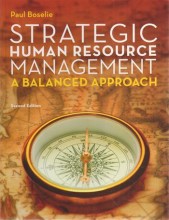Human Resource Management and Performance: Adding value through people/managment en prestaties
11 important questions on Human Resource Management and Performance: Adding value through people/managment en prestaties
What is the reversed approach of the HR value chain?
- Determine UBG's
- Critical and non critical HR goals
- HR outcomes
- HR practices
What is the difference between an organization and a professional organization?
A professional organization has on top of that two other things:
- Participants earn their living
- Continuity
When is the highest level in the VRIO framework achieved?
- Higher grades + faster learning
- Never study anything twice
- 100% sure, 100% understanding
Imitability is one of the most important qualities of a resource. A resources can be imitable for one of the following reasons:
- Path dependency: develop over time
- Causal ambiguity: cause and effect relationships are hard to understand of you where not there
- Social complexity: unique internal and external networks
What are the 3 types of organizational flexibility?
- Numerical flexibility; use of employees during shifts and fluctuations
- Functional; ability to perform multiple taks and functions
- Mental; employees ability and willingness to change without resistance
What are the three reasons a resource could be difficult to intimitate?
- Causal ambiguity; the link between resources prosessed by an organization and its sustained competitive advantage is causally ambiguous. There is a specific cause-and-effect relationship in organizations.
- Social complexity; the resource generating an organization's advantage is socially complex and difficult to understand.
What are the three organizational flexibilities that are distinguished within the model of Boxall & Purcell?
- Functional flexibility; the degree to which employees are capable of performing multiple tasks and functions.
- Mental flexibility; employees ability and willingness to change without resistance.
What are HR outcomes and what two types can be distinguished?
1. Distal outcomes; outcomes with a distance from managerial practices including HR practices. E.g. Market value.
2. Proximal outcomes; are (almost) directly affected by HR interventions or practices. E.g. Employee satisfaction, commitment, motivation, trust, loyalty and retention.
What is the definition of HR practices?
What are the three types in which we can distinguish HR practices?
2. Actual HR practices; implemented by line managers
3. Perceived HR practices; employees experiences and perceptions of HR practices.
What does the HR strategy scan in combination with the HR value chain look like?
The question on the page originate from the summary of the following study material:
- A unique study and practice tool
- Never study anything twice again
- Get the grades you hope for
- 100% sure, 100% understanding

Topics that are related to Human Resource Management and Performance: Adding value through people/managment en prestaties
-
Human Resource Management and Performance: Adding value through people/managment en prestaties - Introduction
-
Human Resource Management and Performance: Adding value through people/managment en prestaties - The VRIO framework
-
Human Resource Management and Performance: Adding value through people/managment en prestaties - Competitve advantage and critical HR goals































